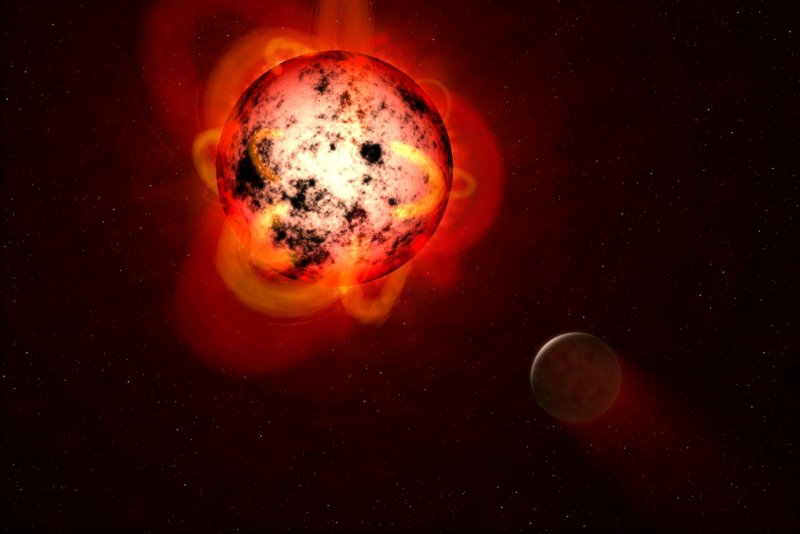An illustration shows a red dwarf star orbited by a hypothetical exoplanet. Scientists have developed a new way to study the environment around exoplanets, which could make it easier to study their potential habitability. Photo by G. Bacon/STScl/ESA/NASA
Feb. 18 (UPI) -- With the help of a powerful radio telescope in the Netherlands, scientists have developed a new way to study the environment around exoplanets.
Using the Low Frequency Array radio telescope, scientists for the first time detected and analyzed radio emissions produced by interactions between a star and one of its planets.
Scientists used observations captured by the HARPS-N telescope in Spain to confirm the emissions weren't caused by interactions between the star and a stellar companion.
The radio signatures detected by the LOFAR telescope are similar to the electromagnetic signatures produced by an aurora on Earth.
The research, described this week in both Nature Astronomy and Astrophysical Journal Letters, focused on red dwarfs. In addition to being the most abundant stars in the universe, red dwarfs also produce particularly powerful magnetic fields. As a result, exoplanets circling red dwarfs are exposed to intense magnetic activity.
The magnetic fields of red dwarfs are strong enough to erode the atmospheres of exoplanets. The erosion process produces heat, which yields radio signals.
"The motion of the planet through a red dwarf's strong magnetic field acts like an electric engine much in the same way a bicycle dynamo works," Harish Vedantham, researcher at the Netherlands Institute for Radio Astronomy, said in a news release. "This generates a huge current that powers aurorae and radio emission on the star."
The sun's magnetic field is too weak and its planets too far away to generate such radio emissions, but interactions between Jupiter's moon Io and the gas giant's magnetic field does produce a bright radio emission.
LOFAR spotted the radio signature within the planetary system surrounding the red dwarf star GJ 1151, which is located some 25 light-years from Earth.
Scientists confirmed there are not any stellar, brown dwarf or giant planet companions within a close enough orbit to account for the radio emissions detected by LOFAR.
"Our data are consistent with detected radio emission emerging from a magnetic interaction between a short-period terrestrial-mass planet and GJ 1151," scientists wrote in their paper.
Researchers are now looking for similar signatures in neighboring red dwarf planetary systems, with hopes of developing new ways of using these star-exoplanet interactions to study the habitability of alien worlds.
"The long-term aim is to determine what impact the star's magnetic activity has on an exoplanet's habitability, and radio emissions are a big piece of that puzzle," said Vedantham. "Our work has shown that this is viable with the new generation of radio telescopes and put us on an exciting path."















